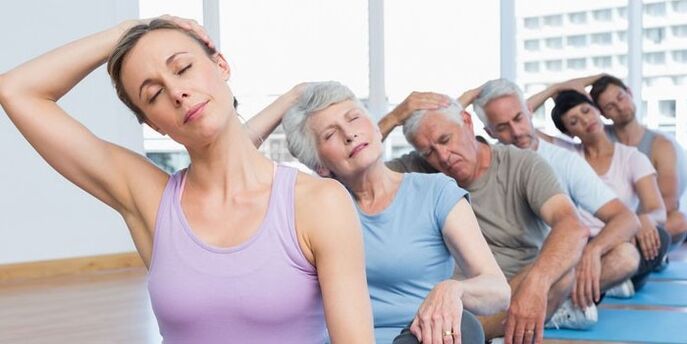Sedentary work, spinal cord injuries, overweight - there are many reasons why osteochondrosis (a dystrophic disorder in the intervertebral disc) develops. Pathological changes develop over the years, gradually making themselves felt with numbness of the hands, a burning sensation between the shoulder blades, pain in the neck and other unpleasant symptoms. You can help yourself if you start exercising on time.
Benefits of exercise therapy for cervical spine osteochondrosis
Recently, osteochondrosis of the cervical spine was considered an age-related disease, but today the disease is becoming younger and can occur even in patients aged 20-30 years. It is not possible to completely get rid of dystrophic disorders, but the treatment chosen significantly improves the quality of life of patients. One of the main places in the treatment of osteochondrosis is occupied by the therapeutic and physical culture complex (LFK). Simple exercises have many benefits:
- They help strengthen the muscular corset, improve muscle tone and ligament elasticity, thus significantly reducing the load on the spine.
- Regular exercise relieves neck pain, headaches, burning sensation between the shoulder blades.
- Gymnastics with cervical osteochondrosis activates blood flow, reduces the chances of stroke and increases the supply of oxygen to the brain.
- Classes at an early stage allow you to stop the development of dystrophic processes, improve posture.
Indications and contraindications
Charging with osteochondrosis is prescribed during the remission period, when the pain subsides. It helps to relieve bitterness, prevents the development of recurrent attacks of pain, complications and further destruction of the joints. Patients with mild spinal cord injuries, diabetes mellitus, arterial hypertension should perform the prescribed exercises in a mild version and initially only under the supervision of a doctor or trainer.
You should not start exercising immediately after a meal, on an empty stomach, or after strenuous physical work. Physiotherapy exercises are also contraindicated in the presence of the following pathological conditions:
- arterial hypertension;
- arrhythmias, tachycardia;
- glaucoma, severe myopia;
- diseases of the vestibular apparatus, which are accompanied by impaired coordination;
- infectious lesions of the spine;
- period of exacerbation of osteochondrosis;
- aortic aneurysm;
- post -infarction conditions in the early recovery stage;
- severe spinal cord injury;
- acute respiratory viral disease.

Implementation rules
Before starting gymnastics with cervical osteochondrosis, it is useful to familiarize yourself with the general rules of physical education:
- Exercise must be done in a well -ventilated area.
- Clothing for training should be loose, not restrict movement and not bring discomfort.
- Before class, you should measure the pulse and pressure, in case of an increase, refuse to do exercises.
- To reduce the risk of injury, all movements should be performed smoothly, gradually increasing the load, intensity and number of repetitions, maintaining your posture.
- Gymnastics with cervical osteochondrosis should be done regularly. Lots of great exercises to do at work, while studying.
- If during exercise therapy you feel a sharp pain, dizziness, begin to feel pain, immediately stop further exercise and sit down to rest. In the future, reduce the load and seek medical advice.
- In addition to training, a course of therapeutic massage, physiotherapy can be prescribed.
Exercise for cervical osteochondrosis at home
Therapeutic gymnastics involves doing a series of simple exercises. With a doctor’s permission, they can be done at home with relaxing music. The main condition is that the spine should be as evenly as possible, so it is better not to lie down, but practice standing or sitting on a chair without a back. For a lasting therapeutic effect, do gymnastics every day at the same time.
Why warm up?
An important part of any physical activity is muscle preparation. Mild warm -ups will help prevent injuries, warm up muscles, prepare the body for the start of intense exercise, improve blood circulation and stretching. Example of an exercise set:
- Sit in a chair with your back straight, relax and lower your arms along your torso. Perform circular movements with your shoulders, first forward, then backward. Do 5-10 repetitions on each side.
- Staying in the same position, stretch your arms parallel to the floor. With inhalation, bend your elbows, touch your shoulders gently with your fingertips. With an exhale, return to the starting position. Make 10 connections.
- Stand up straight, place your palms on your shoulders, elbows parallel to the floor. On a count of one or two, start a circular movement alternating with your elbows. First, with your right hand, reach the end of the circle, connect your left elbow. Do 5 circles for each hand.
- Take a starting position, as for the first exercise. Tighten your arms, start moving your shoulders back and forth. Repeat the procedure 10 times for each side.
Isometric exercises for the neck with osteochondrosis
This complex involves doing all the exercises without moving the head or neck - only with the help of muscle tension. Isometric gymnastics for cervical osteochondrosis is considered the safest, therefore, it is prescribed to patients to relieve pain during exacerbation of the disease. All exercises are performed from a position: standing or sitting on a chair without a back. The duration of one task is 5 seconds, the number of approaches is 2–5. Examples of effective training:
- Lock your fingers together and place your palms on your forehead. Start pressing your hands on your forehead, as if trying to tilt your head, fighting with the neck muscles so that the body remains motionless.
- Move your hands in the same position to the back of your head. Pressing with the palms of your hands, make micro movements of the head forward. At the same time, hold the arm with the neck and forearm muscles.
- Place your right hand on your cheek with the palm of your hand. Press your hands on your face, trying to tilt your head to the left. At the same time, tighten the muscles, not allowing the head to bend. Do the same exercise with your left hand.
- Stand up, spread your legs shoulder -width apart. Hands to sides, palms out. Tighten the muscles in your neck, arms and back. Force your elbows together, then backwards, trying to place your hands as far back as possible. Carry and extend the elbows carefully, without relieving tension from the muscles and maintaining balance.
dynamic gymnastics
Physical education in cervical osteochondrosis necessarily contains exercises aimed at strengthening and improving the muscle tone of the upper limbs, neck, shoulder girdle, and lower back. This is the purpose of dynamic assignments. Everything is done at a fast pace, between sets there is a break of 10-15 seconds. You should know that dynamic gymnastics is contraindicated in the severity of osteochondrosis, diabetes, spinal cord injuries, and cardiovascular disease.
Exercise set budget:
- Stand up straight, bring your legs together, place your hands on your hips. Slowly tilt your head, trying to reach your shoulders with your ears. Do 5-6 repetitions for each side.
- Sit or stand, slowly raise your hands up, bring your palms together. As you exhale, slowly return to the starting position. Do 10-15 repetitions.
- Stand up, spread your legs, lower your arms along the torso. Make a circular rotation simultaneously with your shoulders without lifting your hands. Perform 15 circular movements in 3 sets. To complicate it, you can do alternating circles - first with the left, then with the right shoulder.
- Standing, pull your right hand firmly back, while lifting your left hand simultaneously. Perform 10 repetitions and 3 sets for each limb.
- Standing, lower your arms along your torso. Make a stroking motion alternately sliding to the side, lifting your shoulders as much as possible. Do the task for 1 minute, then rest and 2 more sets.

A set of exercises for osteochondrosis of the cervical spine
Many rehabilitation doctor patients with the help of exercises for the neck successfully get rid of hypertension, osteochondrosis and other health problems. Doctors claim that his physical education helps improve blood circulation, develop muscles of the neck and upper spine, and prevent the development of heart attacks and strokes. Gymnastics for cervical osteochondrosis will be useful during the recovery period after surgical intervention or injury and for those with the following pathologies:
- hypertension;
- drowsiness or insomnia;
- chronic migraine;
- memory impairment.
The authors of the technique recommend that all exercises be performed from a sitting position. It is important to take care of your back as often as possible and not to rush, otherwise you will not only not get a positive result, but also worsen your condition. To monitor your posture, in the early stages, do a program in front of a mirror. The training scheme is as follows: the first two weeks - every day, then 3-4 exercises a week.
Therapeutic exercises for osteochondrosis of the cervical spine have certain contraindications. Gymnastics should not be done with:
- high body temperature, general lethargy, weakness;
- exacerbation of osteochondrosis;
- oncological diseases;
- disc herniation;
- during pregnancy;
- infectious and viral diseases;
- risk of internal bleeding.
7 exercises for the neck and shoulders
The complex consists of seven tasks, which must be performed while sitting on a chair without a back or other hard surface. All exercises for the treatment of cervical osteochondrosis are shown in the table below:
| The name of the exercise | Initial position | Basic steps | Number of repetitions |
|---|---|---|---|
| spring | Sitting in front of a mirror, arms lowered along the body, head straight. | Pull your chin to your neck as much as possible. Hold for 20 seconds, then slowly pull your chin forward and up. After 20 seconds, return to starting position. | five |
| Metronome | Sitting in front of a mirror, arms lowered along the body, head straight. | Lower your head to the right to the maximum. Lock the position for 10 seconds. Slowly return to the starting position and repeat the same for the other side. | five |
| A view of the sky | Same | Keep your head straight, chin parallel to the floor. Slowly turn your head to the right, correcting the position for 10 seconds. Go back to the beginning and repeat the same for the other side. | five |
| goose | Sit, arms along body, chin extended forward. | From the starting position, slowly turn your head to the right and down, trying to reach your shoulders with your chin. Freeze for 10 seconds, then repeat the task for the other parts. | 6 |
| Frame | Sit, right palm on left shoulder, elbows parallel to the floor. | Reach your chin to the shoulder of your right hand. Hold the position for a few seconds. Smooth back to the beginning. Repeat the same for the left side. | five |
| Fakir | Hands on head with palms together. | Turn your neck to the left, making sure your chin is straight. Freeze for 10 seconds, return to beginning. Repeat the exercise for the left side. | 7 |
| Stork | Sit on a chair with your back straight. | Straighten your hands, palms towards the floor. Pull them back while pulling your chin forward. Hold the body position for 20 seconds. | 4 |
Therapeutic effects and results
Therapeutic training for osteochondrosis of the cervical spine helps to improve the course of the disease in a short time, and with continued performance, cures osteochondrosis without taking medication. It is absolutely not necessary to immediately implement the entire complex of health of the proposed exercises, beginners can choose the ones given to them without much effort and gradually increase the amount. After achieving a therapeutic effect, you can not stop exercising, the improvement of the condition must always be maintained.
If there are no strict contraindications, you can stretch the spine on a horizontal bar. Such exercises help put the intervertebral disc in place, provide energy, strengthen the muscular corset. Ideal for swimming, dancing, light fitness, yoga or aerobics. To prevent osteochondrosis and complete recovery, doctors recommend maintaining an active lifestyle and organizing the workspace properly.
























